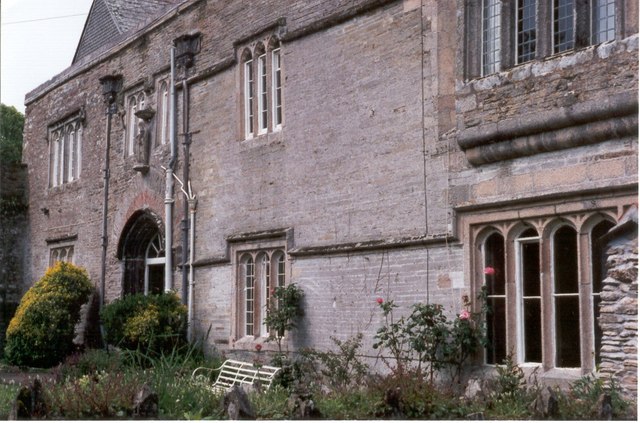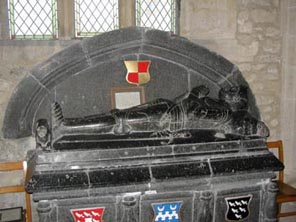John Cornelius a Roman Catholic Priest, was born c1557 at Bodmin in Cornwall, on the estate of Sir John Arundell of Lanherne, into a Roman Catholic family from Ireland. His exact parentage seems to be in some dispute with the Dictionary of National Biography stating that he was possibly the son of Gervaise Cornelius and Maud (or Mary) Buckingham. It acknowledges however that his parents were Irish and although living in the humblest station, are said to have sprung from the illustrious family of O'Mahons. The Society of Jesus however maintains that he was baptised with the name of John Conor O'Mahony but used his middle name in a Latinised form. The scene for his eventual destruction was set in 1558 with the ascension of Elizabeth I to the throne as the following year she declared herself Supreme Governor of the Church of England, and instituted an Oath of Supremacy, requiring anyone taking public or church office to swear allegiance to the monarch as head of the Church and state. Anyone refusing to take the Oath could be charged with treason.
There were three levels of penalties for refusal to take the Oath of Supremacy. A first refusal to result in loss of all movable goods. A second offence could mean life in prison and a loss of all real estate possessions. A third offence would result in a charge of High Treason and death. In 1559 it was followed by the Act of Uniformity which established as the Prayer Book of the Church of England a slightly modified form of the 1552 Book of Common Prayer drawn together by Archbishop Thomas Cranmer in the reign of Edward VI. Whilst the small differences between the 1552 and 1559 books are significant the book was strongly Protestant and the Act describes the Rome oriented and ritualistic changes during the intervening reign of Mary a 'decay of the due honour of God'.
A few years later the Oath was extended to include members of parliament and anyone taking a university degree. In 1569, many Catholic nobles took part in the 'Rising of the North' in favour of Mary Queen of Scots, which led to the active persecution of their co-religionists. However many English Catholics trained for the priesthood at the theological colleges in France particularly at Douai and from 1574 onwards entered the country secretly to keep the faith alive against the time when Mary, the heir presumptive, should succeed her cousin Elizabeth.

The Manor House, St Mawgan (Lanherne)
Picture by D Gore under Creative Commons Licence
-
This was the 16th century home of Sir John Arundell and was then the main seat of recusancy in Cornwall. The Arundell's, a Catholic family, had been in Cornwall for many years and wielded strong influence there. But with the arrival of Richard Grenville as Sheriff of Cornwall in 1576, a round up of Catholics began which eventually caused the destruction of papacy in the county.
The catalyst which started the process was the arrest and execution of a seminary priest, Cuthbert Mayne Link to : The Manor House, Golden - scene of St Cuthbert's arrest, who had been secretly infiltrated from France and was serving the Catholic community in mid Cornwall. He covered the area from John Arundell’s house at St Mawgan, south to St Columb and Tregony, and west of Bodmin. [The full story of St Cuthbert and his execution at Launceston in Nov 1577 can be read on line at Google Books in a book called Soldiers, Saints and Scallywags by David Gore]. Francis Tregian who had been host to Cuthbert at Tregony was imprisoned for 26 years. Sir John Arundell too was imprisoned briefly and the influence of his family was lost forever.
Sir John Arundell took an active interest in the young but talented boy and early in the 1570's sent him to Exeter College Oxford for his formal education. His surname however pointed to his Catholic background and given the persecution prevalent after 1569 he entered the College under the name of John Cornelius where he was made a Fellow of the University on 30 June 1575. Three years later however he was examined by Royal Commissioners as required by the amended Act and on 3rd August 1578 he was expelled from the University for Popery. In fear of his life and not prepared to give up his beliefs he fled across the channel to France and enrolled at the English College at Rheims on 26 Sep 1579. From there on 9 February 1580 he was sent on to the English College in Rome arriving on 1 April where he completed his theological studies. It was in Rome therefore that he was ordained deacon on 10 October 1581 and on the Feast of St Stephen that year (26th December) he preached before Pope Gregory XIII. In September 1583 shortly after his ordination to the priesthood he left for England as a missionary. He returned to the care of the Arundell family who had manors and other properties in Devon, Dorset, Gloucestershire, London, Somerset and Wiltshire and in March 1588 he was living with John Arundell at his house in Muswell Hill. He laboured to keep the faith alive for ten years using the name of John Mohun practicing mortification, meditation, and showed much zeal in the ministry, even becoming a noted exorcist.
 After the death of Sir John Arundell on 17 January 1591 (<<<See picture of his tomb in St Giles Church Chideock) Cornelius accompanied his widow Lady Anne Arundell to live at Chideock Castle in Dorset. Unfortunately this Castle was destroyed during the Civil War having changed hands several times. While acting as her chaplain, the castle was raided by the Sheriff of Dorset Sir George Trenchard of Wolfeton on 14 April, 1594 and after a search of five or six hours he was betrayed by one of the servants and discovered in a priest hole in the castle. He was met on the way by Thomas Bosgrave, a relative of the Arundell family, who offered him his own hat, as he had been dragged out bareheaded. Thereupon Bosgrave was also arrested. Two servants of the castle, John (or Terence) Carey and Patrick Salmon, natives of Dublin, shared the same fate. Imprisoned in Trenchard's house Cornelius met a number of protestant divines and according to 'More', Sir Walter Raleigh also discussed unspecified issues with Cornelius for one night in order to 'remove his doubts'. Despite Raleigh's displeasure at something Cornelius said about atheism the courtier promised to intercede with Elizabeth I on the priest's behalf.
After the death of Sir John Arundell on 17 January 1591 (<<<See picture of his tomb in St Giles Church Chideock) Cornelius accompanied his widow Lady Anne Arundell to live at Chideock Castle in Dorset. Unfortunately this Castle was destroyed during the Civil War having changed hands several times. While acting as her chaplain, the castle was raided by the Sheriff of Dorset Sir George Trenchard of Wolfeton on 14 April, 1594 and after a search of five or six hours he was betrayed by one of the servants and discovered in a priest hole in the castle. He was met on the way by Thomas Bosgrave, a relative of the Arundell family, who offered him his own hat, as he had been dragged out bareheaded. Thereupon Bosgrave was also arrested. Two servants of the castle, John (or Terence) Carey and Patrick Salmon, natives of Dublin, shared the same fate. Imprisoned in Trenchard's house Cornelius met a number of protestant divines and according to 'More', Sir Walter Raleigh also discussed unspecified issues with Cornelius for one night in order to 'remove his doubts'. Despite Raleigh's displeasure at something Cornelius said about atheism the courtier promised to intercede with Elizabeth I on the priest's behalf. At the end of April John Cornelius was sent to London to the Marshalsea prison and brought before the Lord Treasurer, the Archbishop of Canterbury, and others, who, by words and torture, tried in vain to obtain the names of such as had given him shelter or assistance. In late June he was sent back to Dorchester for trial and with his three companions found guilty on 2 July 1594: Cornelius of high treason for being a priest and coming into the kingdom and remaining there, the others with a felony, for having rendered assistance to one whom they knew to be a priest; but all were assured that their lives would be spared if they embraced Protestantism.
While in prison, John Cornelius on his own initiative pronounced Jesuit vows seeking admittance to membership in the Society of Jesus. On the way to execution none of the confessors showed signs of fear. The first to ascend the scaffold was John Carey; he kissed the rope, exclaiming "O precious collar", made a solemn profession of faith and died a valiant death. Before his execution Patrick Salmon, a man much admired for his virtues, exhorted the spectators to embrace the Faith, for which he and his companions were giving their lives. Then followed Thomas Bosgrave, a man of education, who delivered a stirring address on the truth of his belief. The last to suffer was John Cornelius, who kissed the gallows with the words of St. Andrew, "O Cross, long desired", etc. On the ladder he tried to speak to the multitude, but was prevented. After praying for his executioners and for the welfare of the queen, John Cornelius also was executed. The body was taken down and quartered, his head was nailed to the gibbet, but soon removed. According to David Underdown "the memory of his dismemberment was kept alive for years by the sight of his head displayed atop of the town gates. Pious Catholics believed that the heavy mortality of 1597 was God's punishment on the town for this act". The bodies were later stolen and properly buried by Catholic sympathisers. In 1929 he was beatified by Pope Pius XI.
National Portrait Gallery Picture
Sources & Acknowledgements:-
(1). Oxford University Alumni - register of students, graduates, and officers who attended Oxford University between 1500 and 1886. Original data: Foster, Joseph. Alumni Oxonienses: The Members of the University of Oxford, 1715-1886 and Alumni Oxonienses: The Members of the University of Oxford, 1500-1714. Oxford: Parker and Co., 1888-1892.
(2). Boase 46; and Dictionary of National Biography pages 438/9
(3). Roman catholics -The Dictionary of Genealogy by Terrick V.H.Hugh published 1988
(4). Irondequoit Catholic Communities
(5). http://www.ewtn.com/library/MARY/08459A.HTM
(6). Catholic Encyclopedia
(7). http://www.www.newadvent.org/cathen/08459a.htm
(8). http://saints.sqpn.com/saintj7j.htm
(9). The Arundell family
(10). Fire from Heaven by David Underdown page 17
(11). Another account of the fate of his head is given in 'The History of the Dorchester Gallows' by the Rev. SEV Filleul MA. Published on pages 61 to 69 of "Proceedings of the Dorset Natural History & Antiquarian Field Club edited by C.W.H.Dicker Volume XXX II printed at Dorchester at Dorset County Chronicle Office 1911